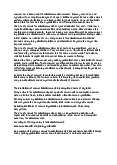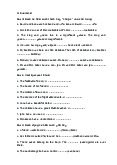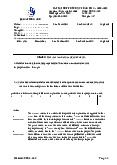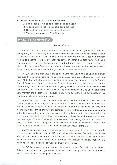






Preview text:
Problems 179
strategies can reduce a larger game to a 2 2 game, an algebraic solution procedure can
be used to find a solution. If the game cannot be reduced to a 2 2 game, a linear pro-
gramming model is needed to determine the optimal mixed strategy solution. Glossary
Utility A measure of the total worth of a consequence reflecting a decision maker’s atti-
tude toward considerations such as profit, loss, and risk.
Lottery A hypothetical investment alternative with a probability p of obtaining the best
payoff and a probability of (1 )
p of obtaining the worst payoff.
Risk avoider A decision maker who would choose a guaranteed payoff over a lottery with a better expected payoff.
Expected utility (EU) The weighted average of the utilities associated with a decision al-
ternative. The weights are the state-of-nature probabilities.
Risk taker A decision maker who would choose a lottery over a better guaranteed payoff.
Utility function for money A curve that depicts the relationship between monetary value and utility.
Risk-neutral decision maker A decision maker who is neutral to risk. For this decision
maker the decision alternative with the best expected monetary value is identical to the al-
ternative with the highest expected utility.
Game theory The study of decision situations in which two or more players compete as
adversaries. The combination of strategies chosen by the players determines the value of the game to each player.
Two-person, zero-sum game A game with two players in which the gain to one player is
equal to the loss to the other player.
Saddle point A condition that exists when pure strategies are optimal for both players in
a two-person, zero-sum game. The saddle point occurs at the intersection of the optimal
strategies for the players, and the value of the saddle point is the value of the game.
Pure strategy A game solution that provides a single best strategy for each player.
Mixed strategy A game solution in which the player randomly selects the strategy to play
from among several strategies with positive probabilities. The solution to the mixed strat-
egy game identifies the probabilities that each player should use to randomly select the strat- egy to play.
Dominated strategy A strategy is dominated if another strategy is at least as good for
every strategy that the opposing player may employ. A dominated strategy will never be se-
lected by the player and as such can be eliminated in order to reduce the size of the game. Problems 1.
A firm has three investment alternatives. Payoffs are in thousands of dollars. S E L t F est Economic Conditions Decision Alternative Up s Stable s Down s 1 2 3 Investment A, d 100 25 0 1 Investment B, d 75 50 25 2 Investment C, d 50 50 50 3 Probabilities 0.40 0.30 0.30 180 Chapter 5 Utility and Game Theory a.
Using the expected value approach, which decision is preferred? b.
For the lottery having a payoff of $100,000 with probability p and $0 with probability
(1 p), two decision makers expressed the following indifference probabilities. Find
the most preferred decision for each decision maker using the expected utility approach.
Indifference Probability ( ) p Profit Decision Maker A Decision Maker B $75,000 0.80 0.60 $50,000 0.60 0.30 $25,000 0.30 0.15 c.
Why don’t decision makers A and B select the same decision alternative?
2. Alexander Industries is considering purchasing an insurance policy for its new office
building in St. Louis, Missouri. The policy has an annual cost of $10,000. If Alexan-
der Industries doesn’t purchase the insurance and minor fire damage occurs, a cost of
$100,000 is anticipated; the cost if major or total destruction occurs is $200,000. The
costs, including the state-of-nature probabilities, are as follows: Damage Decision Alternative None s Minor s Major s 1 2 3 Purchase insurance, d 10,000 10,000 10,000 1
Do not purchase insurance, d 0 100,000 200,000 2 Probabilities 0.96 0.03 0.01 a.
Using the expected value approach, what decision do you recommend? b.
What lottery would you use to assess utilities? (Note: Because the data are costs, the best payoff is $0.) c.
Assume that you found the following indifference probabilities for the lottery defined
in part (b). What decision would you recommend? Cost
Indifference Probability 10,000 p 0.99 100,000 p 0.60 d.
Do you favor using expected value or expected utility for this decision problem? Why? 3.
In a certain state lottery, a lottery ticket costs $2. In terms of the decision to purchase or
not to purchase a lottery ticket, suppose that the following payoff table applies: State of Nature Decision Alternatives Win s Loses s 1 2
Purchase lottery ticket, d 300,000 2 1
Do not purchase lottery ticket, d 0 0 2 Problems 181 a.
A realistic estimate of the chances of winning is 1 in 250,000. Use the expected value
approach to recommend a decision. b.
If a particular decision maker assigns an indifference probability of 0.000001 to the
$0 payoff, would this individual purchase a lottery ticket? Use expected utility to jus- tify your answer. 4.
Two different routes accommodate travel between two cities. Route A normally takes
60 minutes and route B normally takes 45 minutes. If traffic problems are encountered on
route A, the travel time increases to 70 minutes; traffic problems on route B increase travel
time to 90 minutes. The probability of a delay is 0.20 for route A and 0.30 for route B. a.
Using the expected value approach, what is the recommended route? b.
If utilities are to be assigned to the travel times, what is the appropriate lottery? (Note:
The smaller times should reflect higher utilities.) c.
Use the lottery of part (b) and assume that the decision maker expresses indifference probabilities of
p 0.80 for 60 minutes
p 0.60 for 70 minutes
What route should this decision maker select? Is the decision maker a risk taker or a risk avoider? 5.
Three decision makers have assessed utilities for the following decision problem (payoff in dollars): S E L t F est State of Nature Decision Alternative s s s 1 2 3 d 20 50 20 1 d 80 100 100 2
The indifference probabilities are as follows:
Indifference Probability ( ) p Payoff Decision Maker A Decision Maker B Decision Maker C 100 1.00 1.00 1.00 80 0.95 0.70 0.90 50 0.90 0.60 0.75 20 0.70 0.45 0.60 20 0.50 0.25 0.40 100 0.00 0.00 0.00 a.
Plot the utility function for money for each decision maker. b.
Classify each decision maker as a risk avoider, a risk taker, or risk neutral. c.
For the payoff of 20, what is the premium that the risk avoider will pay to avoid risk?
What is the premium that the risk taker will pay to have the opportunity of the high payoff? 6.
In Problem 5, if P(s ) 0.25, P(s ) ) 1 2
0.50, and P(s3 0.25, find a recommended deci-
sion for each of the three decision makers. (Note: For the same decision problem, differ-
ent utilities can lead to different decisions.) 182 Chapter 5 Utility and Game Theory 7.
Suppose that the point spread for a particular sporting event is 10 points and that with this
spread you are convinced you would have a 0.60 probability of winning a bet on your
team. However, the local bookie will accept only a $1000 bet. Assuming that such bets
are legal, would you bet on your team? (Disregard any commission charged by the
bookie.) Remember that you must pay losses out of your own pocket. Your payoff table is as follows: State of Nature Decision Alternatives You Win You Lose Bet $1000 $1000 Don’t bet $0 $0 a.
What decision does the expected value approach recommend? b.
What is your indifference probability for the $0 payoff? (Although this choice isn’t
easy, be as realistic as possible. It is required for an analysis that reflects your attitude toward risk.) c.
What decision would you make based on the expected utility approach? In this case
are you a risk taker or a risk avoider? d.
Would other individuals assess the same utility values you do? Explain. e.
If your decision in part (c) was to place the bet, repeat the analysis assuming a mini- mum bet of $10,000. 8.
A Las Vegas roulette wheel has 38 different numerical values. If an individual bets on one
number and wins, the payoff is 35 to 1. a.
Show a payoff table for a $10 bet on one number for decision alternatives of bet and do not bet. b.
What is the recommended decision using the expected value approach? c.
Do the Las Vegas casinos want risk-taking or risk-avoiding customers? Explain. d.
What range of utility values would a decision maker have to assign to the $0 payoff
in order to have expected utility justify a decision to place the $10 bet? 9.
A new product has the following profit projections and associated probabilities: Profit Probability $150,000 0.10 $100,000 0.25 $ 50,000 0.20 $0 0.15 $ 50,000 0.20 $100,000 0.10 a.
Use the expected value approach to decide whether to market the new product. b.
Because of the high dollar values involved, especially the possibility of a $100,000
loss, the marketing vice president has expressed some concern about the use of the
expected value approach. As a consequence, if a utility analysis is performed, what is the appropriate lottery? c.
Assume that the following indifference probabilities are assigned. Do the utilities
reflect the behavior of a risk taker or a risk avoider? Problems 183 Indifference Profit Probability( ) p $100,000 0.95 $ 50,000 0.70 $0 0.50 $ 50,000 0.25 d.
Use expected utility to make a recommended decision. e.
Should the decision maker feel comfortable with the final decision recommended by the analysis? 10.
A television network has been receiving low ratings for its programs. Currently, manage-
ment is considering two alternatives for the Monday night 8:00 P.M.–9:00 P.M. time slot: a
western with a well-known star or a reality show. The percentages of viewing audience es-
timates depend on the degree of program acceptance. The relevant data are as follows:
Percentage of Viewing Audience Program Acceptance Comedy Reality Show High 30% 40% Moderate 25% 20% Poor 20% 15%
The probabilities associated with program acceptance levels are as follows: Probability Program Acceptance Comedy Reality Show High 0.30 0.30 Moderate 0.60 0.40 Poor 0.10 0.30 a.
Using the expected value approach, which program should the network choose? b.
For a utility analysis, what is the appropriate lottery? c.
Based on the lottery in part (b), assume that the network’s program manager has as-
signed the following indifference probabilities. Based on the use of utility measures,
which program would you recommend? Is the manager a risk taker or a risk avoider? Percentage of Audience
Indifference Probability ( ) p 30% 0.40 25% 0.30 20% 0.10 11.
Consider the following two-person, zero-sum game. Identify the pure strategy. What is the value of the game? S E L t F est 184 Chapter 5 Utility and Game Theory Player B b b b 1 2 3 a 8 5 7 Player A 1 a 2 4 10 2 12.
Two opposing armies, Red and Blue, must each decide whether to attack or defend. These
decisions are made without knowledge of the opposing army’s decision. The payoff table,
in terms of value of property gained or lost for the Red Army, appears below. Any gains
for the Red Army are losses for the Blue Army. Blue Army Attack Defend Red Army Attack 30 50 Defend 40 0 a.
What is the optimal mixed strategy for the Red Army? b.
What is the optimal mixed strategy for the Blue Army? 13.
Two Indiana state senate candidates must decide which city to visit the day before the No-
vember election. The same four cities—Indianapolis, Evansville, Fort Wayne, and South
Bend—are available for both candidates. These cities are listed as strategies 1 to 4 for each
candidate. Travel plans must be made in advance, so the candidates must decide which city
to visit prior to knowing the other candidate’s plans. Values in the following table show
thousands of voters for the Republican candidate based on the strategies selected by the
two candidates. Which city should each candidate visit, and what is the value of the game? Democrat Candidate Fort South Indianapolis Evansville Wayne Bend b b b b 1 2 3 4 Indianapolis, a 0 1 15 8 20 Republican Evansville, a 30 2 5 5 10 Candidate Fort Wayne, a 10 3 25 0 20 South Bend, a 20 20 10 15 4 14.
In Section 5.5, we showed the following two-person, zero-sum game had a mixed strategy: S E L t F est Player B b b b 1 2 3 a 0 1 1 2 Player A a 5 4 3 2 a 2 3 4 3 a.
Use dominance to reduce the game to a 2 2 game. Which strategies are dominated? b.
Determine the optimal mixed strategy solution. c. What is the value of the game? Problems 185 15.
In a gambling game, Player A and Player B both have a $1 and a $5 bill. Each player se-
lects one of the bills without the other player knowing the bill selected. Simultaneously
they both reveal the bills selected. If the bills do not match, Player A wins Player B’s bill.
If the bills match, Player B wins Player A’s bill. a.
Develop the game theory table for this game. The values should be expressed as the
gains (or losses) for Player A. b.
Is there a pure strategy? Why or why not? c.
Determine the optimal strategies and the value of this game. Does the game favor one player over the other? d.
Suppose Player B decides to deviate from the optimal strategy and begins playing each
bill 50% of the time. What should Player A do to improve Player A’s winnings? Com-
ment on why it is important to follow an optimal game theory strategy. 16.
Two companies compete for a share of the soft drink market. Each worked with an adver-
tising agency in order to develop alternative advertising strategies for the coming year. A
variety of television advertisements, product promotions, in-store displays, and so on
provides four different strategies for each company. The following table summarizes the
projected change in market share for Company A once the two companies select their
advertising strategy for the coming year. What is the optimal solution to this game for each
of the players? What is the value of the game? Company B b b b b 1 2 3 4 a 3 0 2 4 1 a 2 Company A 2 2 1 0 a 4 2 5 6 3 a 2 6 1 0 4
17. If a soccer game ends in a tie, it goes into a penalty-kick shootout in which each team
chooses five players to take penalty kicks. The team that makes the most subsequent
penalty kicks wins the game. In a penalty-kick shootout, the shooter and the keeper
each decide simultaneously on a direction to move. They can choose left, right, or mid-
dle. These strategies yield the following game theory table, where the first value is the
shooter’s probability of scoring and the second value is the keeper’s probability of stopping the shot: Keeper Left Center Right Left 0.35, 0.65 0.90, 0.10 0.85. 0.15 Shooter Center 0.30, 0.70 0.25, 0.75 0.45, 0.55 Right 0.95, 0.05 0.90, 0.10 0.30, 0.70
This is an example of a constant-sum game since each pair of entries in the game the-
ory table sums to 1. This can be analyzed in the same manner as a zero-sum game. a.
Use dominance to reduce the game to a 2 2 game. Which strategies are dominated? b.
What is the solution to this game for the shooter and for the keeper? c.
What is the shooter’s expected probability of scoring?




